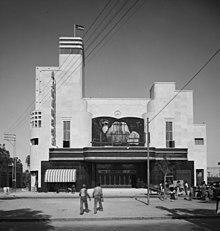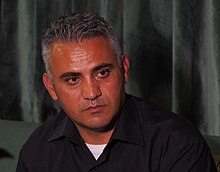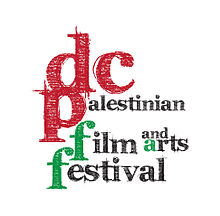Cinema of Palestine
| Cinema of Palestine | |
|---|---|
 | |
| No.ofscreens | 2 (2007)[1] |
| • Per capita | 0.1 per 100,000 (2007)[1] |
| Number of admissions (2007)[2] | |
| Total | 64,026 |
| Part of a series on |
| Palestinians |
|---|
 |
| Demographics |
| Politics |
|
| Religion / religious sites |
| Culture |
| List of Palestinians |
Cinema of Palestinerefers to films made inPalestineand/or byPalestinianfilmmakers. Palestinian films are not exclusively produced inArabicand some are produced inEnglishandFrench.[3][4]
History
[edit]The first period: The beginning, 1935–1948
[edit]
The first Palestinian film to be made is generally believed to be a documentary on KingIbn Saud of Saudi Arabia's visit in 1935 toPalestine,made by Ibrahim Hassan Sirhan (or Serhan), based inJaffa.[5][6]Sirhan followed the King and around Palestine, "fromLodtoJaffaand from Jaffa toTel Aviv".The result was asilent moviethat was presented at theNabi Rubin festivals.Following this documentary, Sirhan joined Jamal al-Asphar to produce a 45-minute film calledThe Realized Dreams,aiming to "promote the orphans' cause". Sirhan and al-Asphar also produced a documentary aboutAhmad Hilmi Pasha,a member of theHigher Arab Commission.[5][7]In 1945 Sirhan established the Arab Film Company with Ahmad Hilmi al-Kilani. The company launched the feature filmHoliday Eve,which was followed by preparations for the next filmA Storm at Home.The films themselves were lost in 1948, when Sirhan had to flee Jaffa after the town was bombarded.[8]
The second period: The epoch of silence, 1948–1967
[edit]
The1948 Palestinian expulsion and flight(known in Arabic as theNakba) had a devastating effect on Palestinian society, including its nascent film industry. Cinematic endeavours, requiring infrastructure, professional crews, and finance, nearly ceased for two decades.[11]Individual Palestinian participated in the film-production of neighbouring countries. It is reported that Sirhan was involved with the production of the first Jordanian feature film,The Struggle in Jarash(1957), and another Palestinian, Abdallah Ka'wash, directed the second Jordanian feature film,My Homeland, My Love,in 1964.[12]
The third period: Cinema in exile, 1968–1982
[edit]After 1967, Palestinian cinema found itself under the auspices of thePLO,funded byFatahand other Palestinian organisations likePFLPandDFLP.More than 60 films were made in this period, mostly documentaries. The first film festival dedicated to Palestinian films was held inBaghdadin 1973, and Baghdad also hosted the next two Palestinian film festivals, in 1976 and 1980.[13]Mustafa Abu Aliwas one of the early Palestinian film directors, and he helped found the Palestinian Cinema Association inBeirutin 1973. Only one dramatic movie was made during the period, namelyReturn to Haifain 1982, an adaptation of a short novel byGhassan Kanafani.[14]
The film archives disappearance, 1982
[edit]Different organisations set up archives for Palestinian films. The largest such archive was run by PLO's Film Foundation/Palestinian Film Unit. In 1982, when the PLO was forced out ofBeirut,the archive was put into storage (in the Red Crescenty Hospital), from where it "disappeared" under circumstances which are still unclear.[15]Recently, several films from the archive were located in theIsrael Defense ForcesArchive inTel HaShomerby scholar and curator Rona Sela.[16]Sela has called for the release of these films, and for the declassification of other Palestinian films that remain closed in the IDF Archive.[17]
The fourth period: The return home, from 1980 to the present
[edit]In 1987, there was the first Intifada,[9]and this led to an increase in news coverage in Palestine, showcasing their occupation. This is when filmmakers started getting back up to make more films, in documentarian style, as they were given the understanding of film techniques through these news reporters. This is when a new era of Palestinian cinema emerged. Focusing on Israeli occupation and Palestinian experiences, it differed from their previous focus on exile during the PLO days. There were also “emergency films” and “roadblock films”[9]which called spectators to action on behalf of Palestinians’ struggles and the other genre categorized for its use of checkpoints in its films. Now in the 2000’s, Palestinian cinema is re focused on collective resistance from Israeli forces.
The 1996drama/comedyChronicle of a Disappearance,from Palestinian filmmaker Elia Suleiman, received international critical acclaim,[18]and it became the first Palestinian movie to receive national release in the United States.[19]A break-out film for its genre, it won a New Director's Prize at theSeattle International Film Festivaland aLuigi De LaurentiisAward at theVenice Film Festival.[20]Notable film directors of this period include[21]Michel Khleifi,Rashid Masharawi,Ali NassarandElia Suleiman.
An international effort was launched in 2008 to reopenCinema Jenin,a cinema located in theJeninRefugee Camp.
In 2008, three Palestinian feature films and an estimated eight shorts were completed, more than ever before.[22]
In 2010,Hamas,the governing authority in theGaza Strip,announced the completion of a new film. TitledThe Great Liberation,the film depicts the destruction of Israel by Palestinians.[23]
Currently in the Gaza Strip, all film projects must be approved by Hamas' Culture Ministry before they can be screened in public. Independent filmmakers have claimed that the Culture Ministry cracks down on content not conforming to Hamas edicts. In a notable 2010 case, Hamas banned the short filmSomething Sweet,directed by Khalil al-Muzzayen, which was submitted at theCannes Film Festival.Hamas banned it from being shown locally due to a four-second scene where a woman is shown with her hair uncovered. In 2011, a film festival hosted by the Gaza Women's Affairs Center included documentaries and fictional pieces on women's issues, but the Culture Ministry censored numerous scenes. One film had to remove a scene where a woman lowered one shoulder of her dress, and another had to remove a scene of a man swearing.[24]
Films from Palestine have been broadcast internationally through services such asNetflix.[25]
Name
[edit]In contrast to the way some otherlocations with associations to film industryare named in casual parlance, the termPallywoodhas only derogatory acceptions.
Notable directors
[edit]
- Hany Abu-Assad
- Mohammed Almughanni
- Yahya Barakat
- Azza El-Hassan
- Mahdi Fleifel
- Scandar Copti
- Mustafa Abu Ali
- Mohammed Bakri
- Tarek Al Eryan
- Annemarie Jacir
- Michel Khleifi
- Rashid Masharawi
- Mai Masri
- Montaser Marai
- Rosalind Nashashibi
- Ali Nassar
- Farah Nabulsi
- Mohammad Al-Sawalma
- Hazim Bitar
- Elia Suleiman
- Leila Sansour
- Refat Adi
- Sameh Zoabi
- Tawfik Abu Wael
- Ameen Nayfeh
- Mohammad Shihadeh Hmedat
- Najwa Najjar
- Hisham Zreiq
Notable films
[edit]- A World Not OursAlam laysa lana
- They Don't ExistComing Home: Palestinian Cinema
- Wedding in Galilee(1987) (International Critics Prize, Cannes),
- Tale of the Three Jewels(1994)
- Chronicle of a Disappearance(1996) ( “Luigi De Laurentiis” Award for a Debut Film at the 1996Venice Film Festival)
- Divine Intervention(2003).
- Olive Harvest, The(2003)
- Arna's Children(2003)
- Jeremy Hardy vs. the Israeli Army(2004)
- Women in Struggle(2004)
- Waiting(2005)
- Paradise Now(2006) (Golden Globe for Best Foreign Language Filmwinner)
- The Color of Olives(2006)
- Iron Wall(2006)
- Goal Dreams(2006)
- First Picture(2006)
- The Sons of Eilaboun(2007)
- Maria's Grotto(2007) (Silver Muhr Award,Dubai International Film Festival)
- Kaffa!(2007) (Silver Award for Short Film,Cairo International TV and Media Festival)(Gold Award for Best Script,Tunis International TV and Media Festival)
- Salt of this Sea(2008)
- Taste the Revolution(2008)
- The View(2008) (Best Short Film ($75,000),Middle East International Film Festival)
- Till When?(2008) (Officially selected in Cergy Pontoise Film Festival in Paris, Honorable Mention in Digicon 6 Festival in Tokyo)
- Spider Web(2009)
- Beyond the Sun(2010) (Audience Choice,Bagdad International Film Festival)
- The Uppercut(2012), a short documentary shot in Jordan telling a story of a slum kickbo xing club[26]
- Solomon's Stone(film) (2015)
- The Present(2020) (nominated for theAcademy Awardfor best Live Action Short Film, won theBAFTA Awardfor Best Short Film.)
- The Teacher(2023) (Best International Film atGalway Film Fleadh[27]and Audience Awards atSan Francisco International Film Festival,[28]Washington DC International Film Festival,[29]Brooklyn Film Festival,[30]Kosmorama[31]and Cyprus Film Days.[32])
- No Other Land(2024) (Berlinale Documentary Film Award and Panorama Audience Award for Best Documentary Film, the74th Berlin International Film Festival)[33][34]
Notable film festivals
[edit]
A
[edit]B
[edit]- Mostra de Cinema Àrab i Mediterrani de Catalunya (Arab and Mediterranean Film Festival of Catalonia) – Barcelona
- Boston Palestine Film Festival
- Muestra de Cine Palestino de Buenos Aires (Buenos Aires Palestine Film Festival)
C
[edit]D
[edit]H
[edit]K
[edit]L
[edit]M
[edit]- Muestra de Cine Palestino de Madrid (Madrid Palestine Film Festival)
- Mizna's Twin Cities Arab Film Festival
- Festival Cinéma Méditerranéen Montpellier (Montpellier Mediterranean Film Festival)
R
[edit]S
[edit]- Muestra de Cine Palestino de Santiago (Santiago Palestine Film Festival)
- Muestra de Cine Palestino de Sevilla (Sevilla Palestine Film Festival)
- Singapore Palestine Film Festival
T
[edit]See also
[edit]References
[edit]- ^ab"Table 8: Cinema Infrastructure - Capacity".UNESCO Institute for Statistics. Archived fromthe originalon 24 December 2018.Retrieved5 November2013.
- ^"Table 11: Exhibition - Admissions & Gross Box Office (GBO)".UNESCO Institute for Statistics. Archived fromthe originalon 25 December 2018.Retrieved5 November2013.
- ^"Palestine Film Foundation".palestinefilm.org.Archived fromthe originalon June 12, 2008.
- ^Brooks, Xan (12 April 2006)."Xan Brooks on Palestinian directors".the Guardian.Retrieved9 July2018.
- ^abGertz and Khleifi, p. 13
- ^Dabashi (2006), p. 9
- ^Khaled Elayya:A Brief History of Palestinian CinemaArchived2014-02-21 at theWayback Machine,This week in Palestine
- ^Gertz and Khleifi, p. 13-14
- ^abcdSheetrit, Ariel M. (2020-09-01)."Nadia Yaqub.Palestinian Cinema in the Days of Revolution.Austin, Tex.: University of Texas Press, 2018. 265 pp ".Critical Inquiry.47(1): 184–185.doi:10.1086/710913.ISSN0093-1896.
- ^List of Irgun attacks
- ^Gertz and Khleifi, p. 19
- ^Gertz and Khleifi, p. 20
- ^Joseph Massad:The weapon of Culture: Cinema in the Palestinian liberation struggle. Ch. 2 in Dabashi (2006), p. 33, 36
- ^Gertz and Khleifi, p. 20-30
- ^Gertz and Khleifi, p. 28-30
- ^Sela, Rona (2017-06-01). "Seized in Beirut: The Plundered Archives of the Palestinian Cinema Institution and Cultural Arts Section".Anthropology of the Middle East.12(1): 83–114.doi:10.3167/ame.2017.120107.ISSN1746-0727.S2CID149169819.
- ^Sela, Rona (3 March 2017). "The Genealogy of Colonial Plunder and Erasure – Israel's Control over Palestinian Archives".Social Semiotics.28(2): 201–229.doi:10.1080/10350330.2017.1291140.S2CID149369385.
- ^Chronicle of a Disappearance.All Movie Guide.Accessed June 7, 2009.
- ^Chronicle of a Disappearance.Artforum.Summer, 1997.
- ^Awards for Chronicle of a Disappearance.ImdbAccessed June 7, 2009.
- ^Gertz and Khleifi, p. 30-34
- ^"Palestinian filmmakers beat the odds to hit silver screen".Edition.cnn.Retrieved9 July2018.
- ^"Gaza-made film shows Israel's destruction by Palestinians".The Jerusalem Post | JPost.2010-09-14.Retrieved2023-11-28.
- ^"Gaza filmmakers decry Hamas censorship".Ynetnews.19 August 2011.Retrieved9 July2018.
- ^"Watch Salt of This Sea | Netflix".netflix.Retrieved2024-03-27.
- ^"200 Meters".Doha Film Institute.Retrieved2024-08-18.
- ^Wiseman, Andreas (July 15, 2024)."'Kneecap' Wins Big At Galway Film Fleadh, Full List Of Winners ".Deadline.Retrieved3 August2024.
- ^Johnson, G. Allen (April 30, 2024)."Palestinian film 'The Teacher' captures SFFilm's top audience award".San Francisco Chronicle.Retrieved7 July2024.
- ^"Past Festivals Audience Award Winners".Filmfest DC.Retrieved7 July2024.
- ^"Festival Winners @ Brooklyn Film Festival".Brooklyn FIlm Festival.Retrieved7 July2024.
- ^"The winners of the new directors award and audience award 2024".Kosmorama.Retrieved7 July2024.
- ^Economou, Vassilis (23 April 2024)."78 Days and Embryo Larva Butterfly win big at the 22nd Cyprus Film Days".Cineuropa.Retrieved7 July2024.
- ^"Berlinale Documentary Award and Jury".berlinale.de.Retrieved2024-03-16.
- ^Goodfellow, Melanie (2024-01-17)."Berlinale Unveils Full Panorama, Forum & Generation Line-Ups With New Films By Nathan Silver, Levan Akin, André Téchiné & Bruce LaBruce".Deadline.Retrieved2024-03-16.
- ^"Poppies of Palestine Film Festival - Kuwait".248am.Retrieved21 May2021.
Further reading
[edit]- Rapfogel, Jared:A Report of Dreams of a Nation - A Palestinian Film Festival,January 24–27, 2003, Senses of Cinema.
- Palestinian film festival planned,18 May 2004,BBC
- Dabashi, Hamid:For a Fistful of Dust: A Passage to Palestine,23–29 September 2004,Al-Ahram
- FilmJan. 14, 2006, IMEU,
- Kemp, Rebecca:“Interviews with Palestinian Filmmakers”,6 Degrees Film, Fall 2006
- Rastegar, Kamran, "Palestine Only Exists in Cinema", Bidoun Magazine, Issue 8, Vol. 1, Fall 2006
- Provan, Alexander (February 2007)."Requesting Permission to Narrate: Dreams of a Nation: On Palestinian Cinema".Stop Smiling Magazine. Archived fromthe originalon October 24, 2007.Retrieved2007-04-09.
- Annemarie Jacir:Coming Home: Palestinian Cinema,27 February 2007,The Electronic Intifada
- Khaled Elayya:A Brief History of Palestinian Cinema,This week in Palestine
- Khadija Habshneh:Palestinian Revolution CinemaArchived2012-02-07 at theWayback Machine,This week in Palestine
- Nana Asfour: Reclaiming Palestine, One Film at a Time,Cineaste Magazine,Vol. XXXIV, No. 3, Summer 2009
- Nana Asfour:Cineaste Magazine - Articles - The Time That Remains and Zindeeq (Web Exclusive)The Time That Remains and Zindeeq, Cineaste Magazine, Web Exclusive, Copyright © 2011 by Cineaste Publishers, Inc.
- Dabashi, Hamid,andSaid, Edward(preface) (2006):Dreams Of A Nation: On Palestinian Cinema,Verso Books, London, United Kingdom,ISBN1-84467-088-0
- Gertz, Nurith;Khleifi, George (2008):Palestinian Cinema: Landscape, Trauma, and Memory,Indiana University Press.ISBN0-253-22007-6
External links
[edit]- Dreams of a Nation,an independent project founded to provide resources and information on Palestinian cinema. Based atColumbia University,United States.
- Palestinian Film: News and Reviews at IMEU.net
- Review of a film that explores the story of the lost archives of the PLO film unit
- History and Trends in Palestinian Filmmaking
- Finding aid to the Palestinian Films Collection, 1976-2008, at Columbia University. Rare Book & Manuscript Library.

